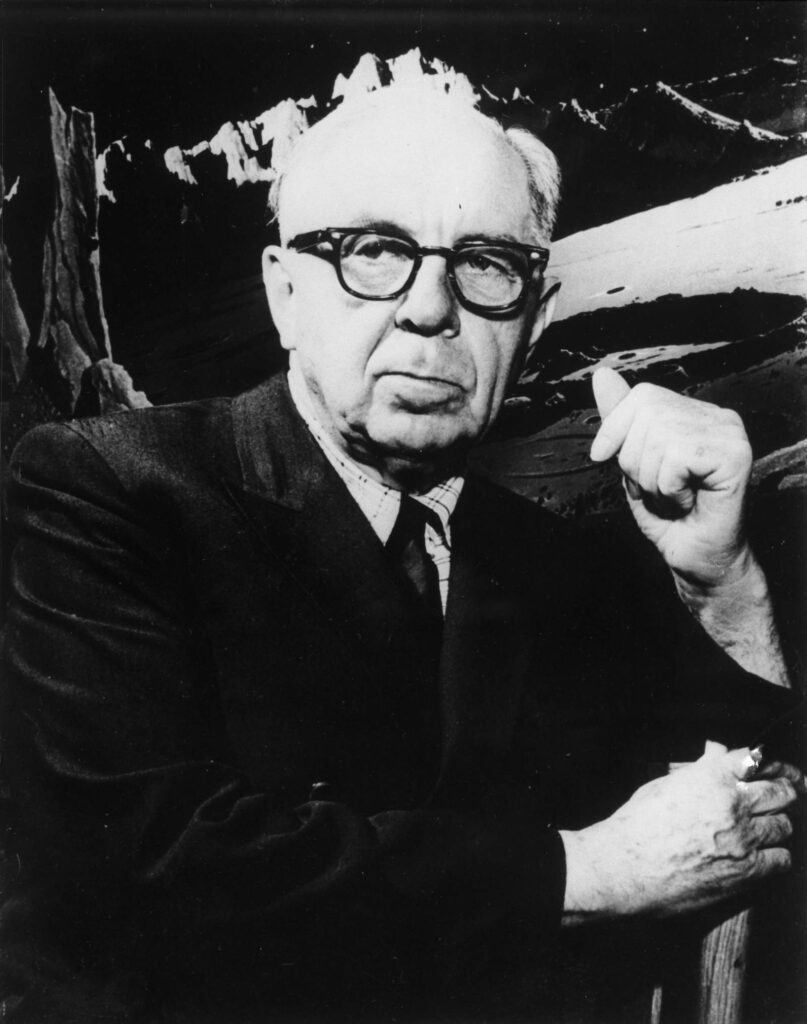Chesley Bonestell was an artist and illustrator who created paintings depicting astronomical scenes and space flight explorations decades before the first manned missions. Bonestell’s paintings electrified generations of space enthusiasts: aspiring writers, astronomers, physicists, artists, engineers, and others.
G. Harry Stine, engineer, author, and co-creator of the hobby of model rocketry, switched his college major from psychology to physics after seeing Bonestell’s book, The Conquest of Space. “Chesley Bonestell not only changed my life,” Stine said, “but motivated two generations of people to start the human race on its way to ultimate freedom among the stars.”
Dr. Carl Sagan said that he didn’t know what other worlds looked like until he saw Bonestell’s paintings of the solar system. Joseph Chamberlain, director of the Adler Planetarium, believed that “It might even be suggested that without Bonestell and his early space age artistry, the NASA era might have been delayed for many years, or it might not even have happened at all.”
Chesley Knight Bonestell was born on New Year’s Day, 1888 in San Francisco, California, into a prosperous well-educated family. He attended Clement Grammar School, Dickensen’s Academy, and St. Ignatius College before graduating high school from George Bates University School at the age of sixteen. Bonestell began drawing and painting at the age of five. When he was ten years old, he began to study astronomy after seeing the planet Venus. When he was twelve, his obvious talent persuaded his parents to let him pursue art as a career rather than the family’s paper business as they had planned. After graduating from George Bates School, he attended the Hopkins Art Institute in San Francisco before moving to New York.
From 1907 to 1910, Bonestell studied architecture at Columbia University then dropped out to work on such landmarks as the Chrysler Building in New York City, the Supreme Court Building in Washington, D.C. and the Golden Gate Bridge in his hometown of San Francisco. In 1938, he began to work in Hollywood, and soon made a reputation for himself in the motion picture industry as a matte artist, working on such classics as The Hunchback of Notre Dame and Citizen Kane. In the early 1940s, Bonestell returned to his childhood interest of doing space illustrations, and in 1944, received great acclaim from layman and scientists alike for paintings of Saturn in Life magazine.
For his realistic portrayals of space exploration, the solar system, and the far off galaxies, Chesley Bonestell became known as the “Dean of Astronomical Artists.” Bonestell’s paintings of Earth-orbiting space stations, rocket ships on Mars, and Saturn as seen from its moon, Titan, influenced public acceptance of space flight and inspired young scientists and engineers to explore the realm of outer space. Bonestell’s realistic renderings of space exploration gave us a glimpse of what later endeavors in space exploration would reveal.
By 1949, Bonestell co-produced the classic book Conquest of Space, which featured 48 of his paintings and text by world-renowned writer Willy Ley. Bonestell’s artwork combined with Ley’s optimistic vision of man’s future in space dazzled millions of readers across the globe and convinced many that the exploration of outer space was worth whatever risks and costs might be required.
Bonestell continued to illustrate influential books and articles, many of which were written by Wernher von Braun, the German-American rocket scientist, with whom he developed a close working relationship. In 1955, Bonestell’s paintings were an important part of the book The World We Live In and two years later graced the pages of Man and the Moon. In 1961, he wrote and illustrated two books, The Solar System and Rocket to the Moon. In 1972, Bonestell produced 25 illustrations for the book Beyond Jupiter, which he published in collaboration with Arthur C. Clarke, who was also greatly influenced by Bonestell’s early astronomical paintings.
Chesley Bonestell died at his home in Carmel, California on June 11, 1986, at the age of 98. Known to many as the “Father of Science Fiction Art,” he received many awards and accolades in his long career, including the International Fantasy Award (1951), the Science Fiction Achievement Special Award (1974), and a lifetime achievement award from the British Interplanetary Society (1976). The annual Chesley Award presented by the Association of Science Fiction and Fantasy Artists since 1986, recognizes individual works and achievements in that field. A crater on Mars and asteroid 3129 Bonestell are also named in his honor.

